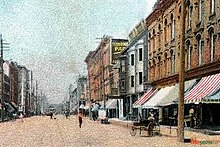Parker Jointless
“The Pen with no joint to leak; no threads to break. The pen with the Lucky Curve. The success of the pen age. You cannot soil your fingers with a Parker Jointless.”[1]

In 1894 and following successive improvements to his 1889 patent about a curved tubular feed, George S. Parker had the Lucky Curve feed properly perfected. This innovative element established a continuous capillary connection between the nib and the inner walls of the barrel avoiding some of the particular problems that, in its time, had the use of fountain pens; difficulty starting the ink flow when starting to write; poor, excessive, or uneven ink flow; ink dripping from the pen when the reservoir was not full or nearly empty, and ink overflowing through the section when the pen was reversed after use.[2]
At the end of 1898 Parker acquired the 3 upper floors of the McKey Building Block at 17-19 South Main Street in the heart of Janesville´s downtown. On the side of this building had a large-scale ad, where we could read: The PARKER PEN COMPANY, Home of the JOINTLESS FOUNTAIN PEN.


The Parker Jointless "Lucky Curve" is a range of fountain pens released by the Parker Pen Company in 1898. The pen used the Lucky Curve ink supply system, designed to draw ink even when the pen was not in use, which was invented and patented by George Safford Parker in 1894. The pen was named "Jointless" because of its one-piece ink barrel, designed to prevent leakage, an innovation at the time – though the design made the refilling process messy.[3] The pen was Parker's first to be advertised outside the United States. The American government purchased the pens in large quantities and a Parker Jointless was one of the pens used to sign the Spanish–American Treaty of Paris in 1898.[4]
See also
- Parker Jotter
- Parker Duofold
- Writing implement
- Quink
References
- "The Parker Jointless Lucky Curve". www.parkersheaffer.com. Retrieved 15 July 2020.
- "The Parker Jointless Lucky Curve". www.parkersheaffer.com. Retrieved 15 July 2020.
- "Middle-Joint, End-Joint & "Jointless" Eyedroppers". www.vintagepens.com. Retrieved 7 March 2017.
- Stead, William Thomas (1900). The Review of Reviews – Volume 21. Office of the Review of Reviews. p. 32. Retrieved 7 March 2017.
- "Parker Pens Penography: LUCKY CURVE". parkerpens.net. Retrieved 7 March 2017.
External links
- A newspaper advertisement for the Parker Jointless, featuring letters of praise
- Official website